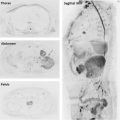Magnetic resonance spectroscopy (MRS) is a noninvasive functional technique to evaluate the biochemical behavior of human tissues. This property has been widely used in assessment and therapy monitoring of brain tumors. MRS studies can be implemented outside the brain, with successful and promising results in the evaluation of prostate and breast cancer, although still with limited reproducibility. As a result of technical improvements, malignancies of the musculoskeletal system and abdominopelvic organs can benefit from the molecular information that MRS provides. The technical challenges and main applications in oncology of 1 H MRS in a clinical setting are the focus of this review.
Key points
- •
Magnetic resonance spectroscopy (MRS) is able to determine the tissue chemical composition of a certain tissue, providing clinical valuable information for oncologic molecular imaging.
- •
Clinical MRS is mainly based on 1 H protons, which is technically challenging and needs robust quality control of sequence design, acquisition including artifact identification and postprocessing, and quantification steps for clinical implementation.
- •
MRS increases the overall diagnostic accuracy in multiparametric evaluation of brain tumors and is a key tool especially for lesion characterization, tumor grading, and assessment of local extension, as well as for treatment monitoring.
- •
MRS has been included in routine clinical MR imaging protocols for prostate cancer assessment for years, although its role is now under debate because of limited reproducibility, complex interpretation, and long acquisition time.
- •
Choline has emerged as a metabolic hallmark of malignancy in tumors of breast, the musculoskeletal system, and other abdominopelvic organs.
Introduction
Magnetic resonance spectroscopy (MRS) creates a specific spectral curve of the area of interest, because of its ability to depict the tissue chemical composition and analyze the radiofrequency signals generated by the precession frequency of different active molecules in an external magnetic field (B 0 ). In recent years, MRS has gradually been introduced into clinical practice. The capability of MRS to noninvasively determine the concentration of different metabolites in a certain tissue provides powerful biological information not given by other functional techniques performed with MR imaging, such as diffusion-weighted imaging (DWI) or dynamic contrast-enhanced (DCE) MR imaging. MRS can study different endogenous metabolites, such as phosphorus ( 31 P), carbon ( 13 C), sodium ( 23 Na), fluor ( 19 F), or hydrogen ( 1 H) protons. However, because of the high 1 H concentration in the human body and the absence of need for additional hardware, 1 H is the preferred option for most clinical applications, which also provides a higher signal-to-noise ratio (SNR).
The characterization and posttreatment follow-up of tumors in different regions is the most common clinical application of 1 H MRS. 1 H MRS has been used for tumor assessment of the central nervous system (CNS) for years, integrated as part of a multiparametric MR imaging protocol; in some clinical scenarios, it is the only tool with discriminative value. Recent technical advances have favored the spread of 1 H MRS outside the brain. However, this technique has been integrated in clinical settings only in selected anatomic features, such as the prostate, where MRS has been successfully performed for cancer assessment. This slow expansion is mainly because of technical difficulties that limit reproducibility between different centers. The use of MRS for evaluation of other anatomic areas, such as the breast or the musculoskeletal system, is emerging strongly but is still limited to a few centers with sufficient expertise. The implementation of MRS for evaluation of other abdominopelvic organs is progressing even more slowly, because this technique is prone to motion artifacts, but progress is steady and there have been promising results. For all these reasons, MRS has to be considered in the battery of functional MR imaging techniques for evaluation of cancer, because it provides unique biochemical information and can create a specific metabolic fingerprint of different malignancies.
In this review, the focus is on the principles and technical adjustments necessary to perform 1 H MRS in different organs; the clinical experience for the assessment of cancer in the brain and body is also analyzed.
Physical Bases
MRS is based on the same MR principle as conventional MR imaging and can excite and acquire information from nuclei with spin equal to half during the relaxation process. Unlike conventional MR imaging, in which frequency information of the received signal is used for imaging encoding, in MRS, this information is sensitive to the magnetic field shielding of the electron surrounding the nucleus. This property allows MRS to distinguish between different molecular bonds, and therefore, between different chemical compounds. MRS can use this capability to observe in vivo several metabolites, which provides biochemical information from living tissues.
A nucleus inside a molecular bond fills a magnetic field shielding, resulting in the combination of external magnetic field and the molecular bond electron shielding, which can be expressed as:
Stay updated, free articles. Join our Telegram channel

Full access? Get Clinical Tree




